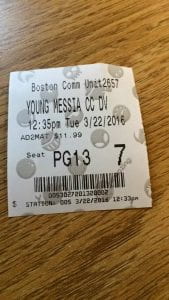For my intervention I plan on going to the movie theater. I will pay for a random movie (the movie doesn’t matter). Once the movie starts I will bring out a book and read it throughout the film. Watch how the other movie goers and theater staff react to you reading a book instead watching the movie, which everyone expects.
Documentation: I went to see the 12:35PM show of the Young Messiah at the AMC Loews Theater because I expected there to be a fair number of people at the theater at noon time. I sat in the front row of the theater so that everyone in the theater could see me. I pulled out my book as the movie started and began reading. It was dark so I assumed that it would take other people in the theater some time to notice that I was reading a book. However, it seemed like the other movie goers were far more interested in the movie. I only observed three people who actually seemed to notice that I wasn’t watching the movie, but reading a book. There was a man who was sitting next to me that was the first to notice. He glanced over but did not seem surprised or seem to care at all. A few moments later he went back to enjoying the movie. Half way into the movie two old ladies left the theater. As they walked towards the exit they saw me reading. They gave me funny looks, but did not question me about it. No one at the theater seemed to really care or notice, which was a little disappointing. I was expecting people to ask questions, but they did not.

Artist Statement:
The original concept for this intervention was to watch a Netflix movie at the movie theater. However, I realized that that would not be possible as the theater I was in did not have wi-fi. I wanted to do this because I thought it was interesting to see how people reacted to me interacting with a media at a setting created for the specific consumption of a different type of media. In any given social setting people have a certain idea of what is acceptable or the “norm.” I wanted to do the complete opposite of the “norm” and see how people reacted.
I was inspired primarily by the Dada artist who created art out of pre-existing things. I created something new out of a pre-existing process which is similar to what the Dadaist did. I was particularly influenced by Marcel Duchamp’s piece The Fountain. The Fountain was essentially a bathroom urinal that Duchamp sent to an art society contest. The society believed that the urinal was a joke and not really art so they rejected the urinal. The society was expecting more conventional forms of art such as painting or sculptures. However, Duchamp decided to do something unconventional and surprising. It inspired me to do something that was unexpected and unconventional. It inspired me to go against what the expected norms were and do something completely unexpected. In this case the expectation was to watch the movie, but by reading instead I went against the established norms like Duchamp.
